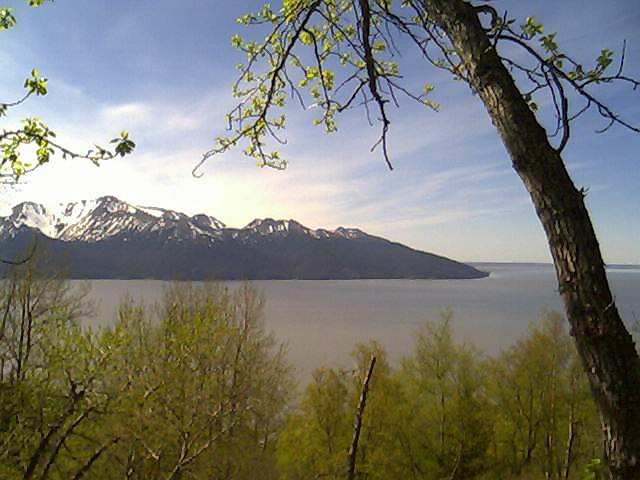


Water - Fishing, Boating, Tours
FISHING
Fishing in Alaska includes both fresh water and salt water species, but the most popular
fish in the state are undoubtedly the saltwater species of salmon and halibut.There are five major kinds of salmon in Alaska, including:
KING SALMON
Also known as Chinook salmon
These are the largest, approaching 100 lbs. in size, but usually in the 50-60 lb. range.
They can be identified by the black spots on both lobes of the caudal fin
a black gum line of the lower jaw, large scales, with anal fin rays numbering15-17 and gillrakers less than 25. SILVER SALMON
Also known as Coho salmon
These are smaller than the King, with small black spots usually only on the upper lobe of
the caudal fin and on back, lower jaw gum line is not black, scales are large, anal
fin rays number 13-15 and gill rakers less than 25.PINK SALMON
Also known as Humpback or Humpy salmon
These guys have large oval black spots on the back and both lobes of the caudal fin, the
scales are very small, and they have more than 12 anal fin rays. Males develop a distinct "hump"
during spawning.SOCKEYE SALMON
Also know as Red or Kokanee salmon
These late comers in the season have no distinct black spots onthe back or tail, 30-40 long, fine and serated
closely spaced gill rakers and over 12 anal fin rays.CHUM SALMON
Also known as Dog salmon
This is the last of the five, in virtually every respect. They are late season salmon, and many Alaskans won't
eat them. They feed them to their dogs, hence the name "dog" salmon. They have no distinct spots on their back
or tail, 18-28 smooth, short, stout, and widely spaced gill rakers, and usually over 12 anal fin rays.The salmon species hatch in fresh water and migrate to saltwater, to return again to their birthplace near the end of their lifespan.
Halibut This flat bottomed fish has the unusual feature that the eye on one side of its head migrates to the opposite side so that they are able to lie flat on the bottom instead of swimming upright like most other fish. They grow to enormous size, and many are caught in the 100 to 300 lb. range. Their white meat is delicious as well. Although they are not known as fighters in the way a King Salmon is, they will give the fisherman a good workout trying to land a fish that is often bigger than the fisher-person who caught it.
For more information on fishing contact the Alaska Department of Fish and Game .
Land - Hiking, Hunting, Land Tours
© August 2001 - Clyde E. Pearce
One of several ponds and lakes on the Johnson Pass trailThe possibilities for hiking around the Anchorage area are enough to last a lifetime. Anchorage is just minutes away from true wilderness areas that are absolutely inaccessible by automobiles or boats, and without established landing sites for aircraft. Moose, bears, and other wildlife are seen even within the city limits. The city itself has greenbelts and paved walking areas suitable for a leisurely stroll or access by less physically active people. There are walks along lakes, the "ocean" (Cook Inlet) or in woods. This is a haven for hikers of all types.
There are also organized walks and runs, one of the more notable being the Summer Solstice event held the end of June. Click here to see Hike photos.
HUNTERS will find opportunities to hunt many species of big game. There are some large animals that can only be hunted by natives, such as the polar bear and beluga whale. Those who have been a resident for one year or more, and are at least 60 years old, can obtain a permanent hunting-fishing-and trapping license. Big game animals hunted in Alaska include bear, bison, caribou, moose, mountain goat, musk ox, Dall sheep, deer, and elk. Be sure to contact the Department of Fish and Game for regulations, licenses, limits, and restrictions on hunting. The Department can be reached at: Hunting Licenses
Winter Sports
Clyde on dog mushers trail behind home
An entire page of Winter sports is listed with telephone numbers on the "150+ Things to do in Anchorage" page. A wonderful winter sport that can be enjoyed as a participant or as an observer is the dogsled races. Although many people are aware of the Iditarod and the Yukon Quest, there are plenty of other dog events in the winter.
The Iditarod was held beginning March 4, 2000 in Downtown Anchorage,with a restart the next day from Wasilla. There were 81 mushers signed up, with 68 finishers. The winner was Swingley, once again, with a winning time of just over nine days. The winning purse was $60,000 this year.
The Yukon Quest began February 12th in Fairbanks, following a trail to Whitehorse, Yukon Territory in Canada.
Both races are over a thousand miles long.Another outdoor winter sport of even longer distance is the Tesoro Iron Dog Classic, a race of snow mobiles across the frozen Arctic in February, beginning on the 12th. This race is 1,900 mile from Big Lake to Nome and finishing in Fairbanks. The total purse is $125,000, with $25,000 of that going to the winner. Thirty-five two person teams competed in 2000. The biggest snow mobile event in terms of number of people attending is the Arctic Man Ski and Sno Go Classic. In 2000 there were over 13,000 people there for this arctic version of Woodstock. Teams of a skier or snowboarder, and a snowmobile race over a five and a half mile course that is fast and furious, and the purse is $60,000. It begins April 12th at Summit Lake, about 12 miles north of Paxson off the Glenn highway.